Get Tamilnadu Board Class 12 Bio Zoology Solutions Chapter wise Study Material to score good marks in the exam. Various chapters with subtopics are explained clearly in Samacheer Kalvi Class 12 Bio Zoology Solutions Material. All the Samacheer Kalvi Class 12 Bio Zoology Book Solutions Chapter 2 Human Reproduction Questions, answers, Notes, Guide, Pdf along with the explanations are provided by the subject experts. Students can easily learn Tamilnadu Board Class 12 Chapter wise Bio Zoology with the help of the step by step guide provided on our site. Learn all the Samacheer Kalvi Class 12 Bio Zoology concepts to attempt the exam with more confidence. Read all the concepts of Tamilnadu Board Solutions for Class 12 Bio Zoology Chapter 2 Human Reproduction.
Tamilnadu Samacheer Kalvi 12th Bio Zoology Solutions Chapter 2 Human Reproduction
Whether you want to become an expert in Bio Zoology or to get good marks in the exam, you have one and only solution is practicing with Samacheer Kalvi 12th Bio Zoology Chapter wise Solutions. Strengthen your weakness by learning the Samacheer Kalvi 12th Bio Zoology Chapter 2 Human Reproduction Questions and Answers on our site. You can learn directly online on our website or learn offline by downloading Samacheer Kalvi 12th Bio Zoology Chapter wise material. Save your time and read Samacheer Kalvi 12th Bio Zoology Subject at your comfort level.
Samacheer Kalvi 12th Bio Zoology Human Reproduction Text Book Back Questions and Answers
Question 1.
The mature sperms are stored in the ________
(a) Seminiferous tubules
(b) Vas deferens
(c) Epididymis
(d) Seminal vesicle
Answer:
(c) Epididymis
Question 2.
The male sex hormone testosterone is secreted from ________
(a) Sertoli cells
(b) Leydig cell
(c) Epididymis
(d) Prostate gland
Answer:
(b) Leydig cell
Question 3.
The glandular accessory organ which produces the largest proportion of semen is ________
(a) Seminal vesicle
(b) Bulbourethral gland
(c) Prostate gland
(d) Mucous gland
Answer:
(a) Seminal vesicle
Question 4.
The male homologue of the female clitoris is ________
(a) Scrotum
(b) Penis
(c) Urethra
(d) Testis
Answer:
(b) Penis
Question 5.
The site of embryo implantation is the ________
(a) Uterus
(b) Peritoneal cavity
(c) Vagina
(d) Fallopian tube
Answer:
(a) Uterus
Question 6.
The foetal membrane that forms the basis of the umbilical cord is ________
(a) Allantois
(b) Amnion
(c) Chorion
(d) Yolk sac
Answer:
(a) Allantois
Question 7.
The most important hormone in initiating and maintaining lactation after birth is ________
(a) Oestrogen
(b) FSH
(c) Prolactin
(d) Oxytocin
Answer:
(c) Prolactin
Question 8.
Mammalian egg is ________
(a) Mesolecithal and non-cleidoic
(b) Microlecithal and non-cleidoic
(c) Alecithal and non-cleidoic
(d) Alecithal and cleidoic
Answer:
(c) Alecithal and non-cleidoic
Question 9.
The process which the sperm undergoes before penetrating the ovum is ________
(a) Spermiation
(b) Cortical reaction
(c) Spermiogenesis
(d) Capacitation
Answer:
(d) Capacitation
Question 10.
The milk secreted by the mammary glands soon after child birth is called ________
(a) Mucous
(b) Colostrum
(c) Lactose
(d) Lactose
Answer:
(b) Colostrum
Question 11.
Colostrum is rich in ________
(a) IgE
(b) IgA
(c) IgD
(d) Ig M
Answer:
(b) IgA
Question 12.
The Androgen Binding Protein (ABP) is produced by ________
(a) Leydig cells
(b) Hypothalamus
(c) Sertoli cells
(d) Pituitary gland
Answer:
(c) Sertoli cells
Question 13.
Which one of the following menstrual irregularities is correctly matched?
(a) Menorrhagia – excessive menstruation
(b) Amenorrhoea – absence of menstruation
(c) Dysmenorrhoea – irregularity of menstruation
(d) Oligomenorrhoea – painful menstruation
Answer:
(b) Amenorrhoea – absence of menstruation
Question 14.
Find the wrongly matched pair:
(a) Bleeding phase – fall in oestrogen and progesterone
(b) Follicular phase – rise in oestrogen
(c) Luteal phase – rise in FSH level
(d) Ovulatory phase – LH surge
Answer:
(c) Luteal phase – rise in FSH level
Question 15.
A – In human male, testes are extra abdominal and lie in scrotal sacs.
R – Scrotum acts as thermoregulator and keeps temperature lower by 2°C for normal sperm production.
Assertion (A) and Reason (R)
(a) A and R are true, R is the correct explanation of A
(b) A and R are true, R is not the correct explanation of A
(c) A is true, R is false
(d) Both A and R are false
Answer:
(a) A and R are true, R is the correct explanation of A
Question 16.
A – Ovulation is the release of ovum from the Graafian follicle.
R – It occurs during the follicular phase of the menstrual cycle.
Assertion (A) and Reason (R)
(a) A and R are true, R is the correct explanation of A
(b) A and R are true, R is not the correct explanation of A
(c) A is true, R is false
(d) Both A and R are false
Answer:
(c) A is true, R is false
Question 17.
A – Head of the sperm consists of acrosome and mitochondria.
R – Acrosome contains spiral rows of mitochondria.
(d) Both A and R are false
Assertion (A) and Reason (R)
(a) A and R are true, R is the correct explanation of A
(b) A and R are true, R is not the correct explanation of A
(c) A is true, R is false
(d) Both A and R are false
Answer:
(d) Both A and R are false
Question 18.
Mention the differences between spermiogenesis and spermatogenesis
Answer:
- Spermiogenesis: Transformation of spermatids into mature sperm.
- Spermatogenesis: Spermatogenesis is the sequence of events in the seminiferous tubules of testes that produces male gametes, the sperms.
Question 19.
At what stage of development are the gametes formed in new born male and female?
Answer:
In males, at puberty the spermatogonia (sperm mother cells) begin to undergo meiotic division and produces sperms through out life, whereas in females during the stage of foetal development, the germinal epithelial cells undergo mitosis and produce oogonia (egg mother cells) and they further enter prophase-I of meiosis-I forming primary oocytes and get arrested. No more oogonia is formed further. At puberty, out of million eggs (prime oocytes) produced at birth only 300-400 will ovulate till menopause.
Question 20.
Expand the acronyms
- FSH
- LH
- hCG
- hPL
Answer:
- FSH – Follicle Stimulating Hormone
- LH – Luteinizing Hormone
- hCG – human Chorionic Gonadotropin
- hPL – human Placental Lactogen
Question 21.
How is polyspermy avoided in humans?
Answer:
Once fertilization is accomplished, cortical granules from the cytoplasm of the ovum form a barrier called the fertilization membrane around the ovum preventing further penetration of other sperms. Thus polyspermy is prevented.
Question 22.
What is colostrum? Write its significance.
Answer:
The mammary glands secrete a yellowish fluid called colostrum during the initial few days after parturition. It has less lactose than milk and almost no fat, but it contains more proteins, vitamin A and minerals. Colostrum is also rich in antibodies. This helps to protect the infant’s digestive tract against bacterial infection.
Question 23.
Placenta is an endocrine tissue. Justify.
Answer:
During pregnancy, the placenta acts as a temporary endocrine gland and produces large quantities of human Chorionic Gonadotropin (hCG), human Chorionic Somatomammotropin (hCS) or human Placental Lactogen (hPL), oestrogens and progesterone which are essential For a normal pregnancy. A hormone called relaxin is also secreted during the later phase of pregnancy which helps in relaxation of the pelvic ligaments at the time of parturition.
Question 24.
Draw a labeled sketch of a spermatozoan.
Answer:
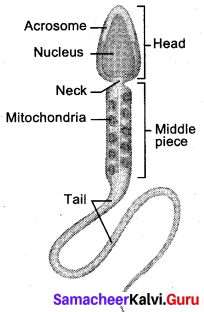
Question 25.
What is inhibin? State its functions.
Answer:
inhibin is a hormone secreted by Sertoli cells of testes which is involved in the negative feedback control of sperm production.
Question 26.
Mention the importance of the position of the testes in humans.
Answer:
The testes are positioned in such a way hanging out from the body in scrotal sac that provides optimal temperature 2°C to 3°C lower than internal body temperature for effective sperm production.
Question 27.
What is the composition of semen?
Answer:
Semen or seminal fluid is a milky white fluid which contains sperms and the seminal plasma, which is secreted from the seminal vesicles, prostate gland and the bulbourethral glands.
Question 28.
Name the hormones produced from the placenta during pregnancy, human Chorionic Gonadotropin (hCG)
Answer:
- human Placental Lactogen (hPL)
- Relaxin.
Question 29.
Define gametogenesis.
Answer:
Gametogenesis is the process of formation of gametes i.e., sperms and ovary from the primary sex organs in all sexually reproducing organisms. Meiosis plays the most significant role in the process of gametogenesis.
Question 30.
Describe the structure of the human ovum with a neat labelled diagram.
Answer:
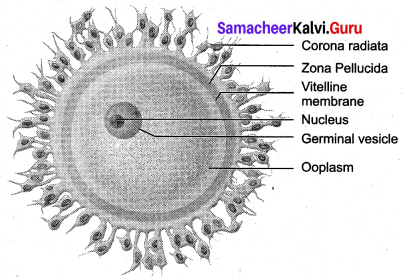
Human ovum is non-cleidoic, alecithal and microscopic in nature. Its cytoplasm called ooplasm contains a large nucleus called the germinal vesicle. The ovum is surrounded by three coverings namely an inner thin transparent vitelline membrane, middle thick zona pellucida and outer thick coat of follicular cells called corona radiata. Between the vitelline membrane and zona pellucida is a narrow perivitelline space.
Question 31.
Give a schematic representation of spermatogenesis and oogenesis in humans
Answer:
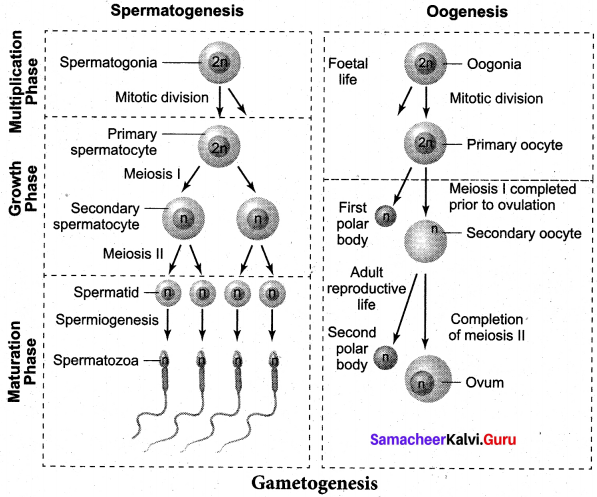
Question 32.
Explain the various phases of the menstrual cycle.
Answer:
Menstrual cycle: The menstrual or ovarian cycle occurs approximately once in every 28/29 days during the reproductive life of the female from menarche (puberty) to menopause except during pregnancy. The cycle of events starting from one menstrual period till the next one is called the menstrual cycle during which cyclic changes occurs in the endometrium every month. Cyclic menstruation is an indicator of normal reproductive phase.
Menstrual cycle comprises of the following phases:
- Menstrual phase
- Follicular or proliferative phase
- Ovulatory phase
- Luteal or secretory phase
1. Menstrual phase: The cycle starts with the menstrual phase when menstrual flow occurs and lasts for 3-5 days. Menstrual flow is due to the breakdown of endometrial lining of the uterus, and its blood vessels due to decline in the level of progesterone and oestrogen. Menstruation occurs only if the released ovum is not fertilized. Absence of menstruation may be an indicator of pregnancy. However it could also be due to stress, hormonal disorder and anaemia.
2. Follicular or proliferative phase: The follicular phase extends from the 5th day of the cycle until the time of ovulation. During this phase, the primary follicle in the ovary grows to become a fully mature Graafian follicle and simultaneously, the endometrium regenerates through proliferation. These changes in the ovary and the uterus are induced by the secretion of gonadotropins like FSH and LH, which increase gradually during the follicular phase. It stimulates follicular development and secretion of oestrogen by the follicle cells.
3. Ovulatory phase: Both LH and FSH attain peak level in the middle of the cycle (about the 14th day). Maximum secretion of LH during the mid cycle called LH surge induces the rupture of the Graafian follicle and the release of the ovum (secondary oocyte) from the ovary wall into the peritoneal cavity. This process is called as ovulation.
4. Luteal or secretory phase: During luteal phase, the remaining part of the Graafian follicle is transformed into a transitory endocrine gland called corpus luteum. The corpus luteum secretes large amount of progesterone which is essential for the maintenance of the endometrium. If fertilization takes place, it paves way for the implantation of the fertilized ovum.
The uterine wall secretes nutritious fluid in the uterus for the foetus. So, this phase is also called as secretory phase. During pregnancy all events of menstrual cycle stop and there is no menstruation. In the absence of fertilization, the corpus luteum degenerates completely and leaves a scar tissue called corpus albicans. It also initiates the disintegration of the endometrium leading to menstruation, marking the next cycle.
Question 33.
Explain the role of oxytocin and relaxin in parturition and lactation.
Answer:
- Relaxin is the hormone secreted by placenta that cause the contraction of pelvic joints and promotes parturition (child birth).
- Oxytocin causes the Let-down reflex – the actual ejection of milk from the alveoli of mammary glands. Oxytocin also stimulates the uterus to regain its pre-pregnancy size after child birth.
Question 34.
Identify the given image and label its parts marked as a, b, c and d.
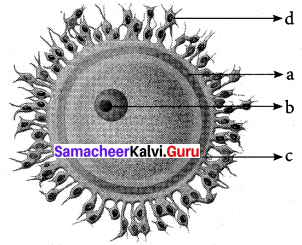
Answer:
The given image is the diagram of human egg cell or ovum
a – vitelline membrane
b – Nucleus
c – Zona pellucida
d – Corona radiata
Question 35.
The following is the illustration of the sequence of ovarian events (a-i) in a human female.

(a) Identify the figure that illustrates ovulation and mention the stage of oogenesis it represents.
(b) Name the ovarian hormone and the pituitary hormone that have caused the above- mentioned events.
(c) Explain the changes that occurs in the uterus simultaneously in anticipation.
(d) Write the difference between C and H.
Answer:
(a) name of types:
A- Primordial follicle
B- Primary follicle
C- Secondary follicle
D-Tertiary follicle
E- Mature graafian follicle
F- Ovulation (release of egg)
G- Empty Graafian follicle
H- Corpus luteum
I – Corpus albicans.
(b) Pituitary hormones: Follicle Stimulating Hormones (FSH) and Lutenizing Hormone (LH). Ovarian hormones: Estrogen and Progesterone.
(c) At the start of menstrual cycle, the endometrium of uterus starts regenerating through proliferation of cells induced by FSH and CH. After ovulation, the progesterone secreted by corpus luteum prepares the endometrium (uterine wall) to receive the egg if it is fertilized.
(d) C- Secondary follicle H – Corpus luteum During development of ovum, the primary follicle gets surrounded by many layers of granular Cells and forms a new layer called secondary follicle. Corpus luteum is the empty graafian follicle that remains after ovulation. It acts as a transitory endocrine gland secreting progesterone to maintain pregnancy.
Samacheer Kalvi 12th Bio Zoology Human Reproduction Additional Questions and Answers
1 – Mark Questions
Question 1.
The developing spermatoza are nourished by _________
(a) Leydig cells
(b) Sertoli cells
(c) Follicular cells
(d) Epididymis
Answer:
(b) Sertoli cells
Question 2.
Identify the correct sequence of reproductive events in human beings.
(a) Insemination, Implantation, Fertilization, Parturition and Placentation.
(b) Implantation, Fertilization, Insemination, Placentation and Parturition.
(c) Implantation, Insemination, Fertilization, Parturition and Placentation.
(d) Insemination, Fertilization, Implantation, Placentation and Parturition.
Answer:
(d) Insemination, Fertilization, Implantation, Placentation and Parturition.
Question 3.
Expulsion of baby from the mother’s womb is referred as _________
Answer:
(a) Ejection
(b) Relaxation
(c) Parturition
(d) Implantation
Answer:
(c) Parturition
Question 4.
Match the Column I with Column II

Answer:
(a) a – ii, b – i, c – iv, d – iii
Question 5.
Which of the following statement is not correct?
(i) Interstitial cells are seen surrounding the seminiferous tubule.
(ii) Nurse cells secrete inhibin.
(iii)Males have single prostate gland which encircles the urethra.
(iv) Insemination, Fertilization, Implantation, Placentation and Parturition.
(a) i and ii
(b) iii only
(c) iii and iv
(d) iv only
(d) iv only
Answer:
(d) iv only
Question 6.
Assertion (A): In scrotum, the temperature is maintained 2 – 3°C lower than body temperature.
Reason (R): Reduced temperature results in efficient sperm production.
(a) R explains A.
(b) A is right R is wrong.
(c) A and R are right. R does not explains A.
(d) Both A and R are wrong.
Answer:
(a) R explains A.
Question 7.
Assertion (A): The acrosome of the sperm cell contains sperm lysin.
Reason (R): Sperm lysin destroys the deformed sperm cells.
(a) R explains A.
(b) A is right, R is wrong.
(c) A and R are right. R does not explains A.
(d) Both A and R are wrong.
Answer:
(A) A is right, R is wrong.
Question 8.
Assertion (A): Human ovum is non – cieidoic
Reason (R): Human does not contain yolk.
(a) R explains A.
(b) A is right, R is wrong.
(c) A and R are right. R does not explains A.
(d) Both A and R are wrong.
Answer:
(c) A and R are right. R does not explains A.
Question 9.
Assertion (A): Menopause refers to the absence of menstruation during pregnancy.
Reason (R): Ovulation occurs during menstrual phase.
(a) R explains A.
(b) A is right, R is wrong.
(c) A and R are right. R does not explains A.
(d) Both A and R are wrong.
Answer:
(d) Both A and R are wrong.
Question 10.
Assertion (A): Cervix is common site of ectopic pregnancies
Reason (R): Implantation of fertilized ovum outside uterus.
(a) A is wrong, R is right.
(b) A is right, R is wrong.
(c) A and R are right. R does not explains A.
(d) Both A and R are wrong.
Answer:
(a) A is wrong, R is right.
Question 11.
Which of the following contributes to the seminal plasma?
(i) Cowper’s gland
(ii) Seminal vesicles
(iii) Prostate gland
(iv) Bulbourethral gland
(a) ii, iii and ii
(b) i, ii, and iii
(c) i, iii and iv
(d) all the above
Answer:
(d) all the above
Question 12.
Organ of copulation in human female is _________
(a) Cevix
(b) Fundus
(c) Vagina
(d) Uterus
Answer:
(c) Vagina
Question 13.
Identify the gland which is homologous to the Cowper’s glands of male.
(a) Bartholin’s gland
(b) Bulbourethral gland
(c) Prostate gland
(d) Skene’s gland
Answer:
(a) Bartholin’s gland
Question 14.
Find out the proper sequence representing the parts of female reproductive system.
(a) Vagina → Ovary → Uterus → Cervix → Infundibulum → Oviduct
(b) Vagina → Ovary → Oviduct → Infundibulum → Cervix → Uterus
(c) Ovary → Infundibulum → Oviduct → Uterus → Cervix → Vagina
(d) Oviduct → Ovary → Uterus → Infundibulum Vagina → Cervix
Answer:
(c) Ovary- Infundibulum → Oviduct → Uterus → Cervix → Vagina
Question 15.
Spermatid → spermatozoa. What does ‘A’ stands for?
(a) Spermatogenesis
(b) Spermiation
(c) Spermiogenesis
(d) Gametogenesis
Answer:
(c) Spermiogenesis
Question 16.
An adult male produces an average of…………….. sperms per day
(a) 200 million
(b) 300 million
(c) 300 billion
(d) 120 million
Answer:
(a) 200 million
Question 17.
Statement (1): During spermiation, the sperms are released into the cavity of I seminiferous tubule.
Statement (2): During spermiogenesis, the spermatids get mature into sperms.
(a) Statement 1 is correct; statement 2 is incorrect.
(b) Statement 1 is incorrect; statement 2 is correct.
(c) Both the statements 1 and 2 are correct.
(d) Both the statements 1 and 2 are incorrect.
Answer:
(c) Both the statements 1 and 2 are correct.
Question 18.
Statement (1): Siamese twins are conjoined twins who are joined during birth.
Statement (2): Dizygotic twins will be of same sex.
(a) Statement 1 is correct; statement 2 is incorrect.
(b) Statement 1 is incorrect; statement 2 is correct.
(c) Both the statements 1 and 2 are correct.
(d) Both the statements 1 and 2 are incorrect.
Answer:
(a) Statment 1 is correct; statement 2 is incorrect.
Question 19.
Statement (1): The endometrium acts as transitory endocrine gland secreting
progesterone
Statement (2): Progesterone maintain pregnancy
(а) Statement 1 is correct; statement 2 is incorrect.
(b) Statement 1 is incorrect; statement 2 is correct.
(c) Both the statements 1 and 2 are correct.
(d) Both the statements 1 and 2 are incorrect.
Answer:
(b) Statement 1 is incorrect; statement 2 is correct
Question 20.
Statement (1): Human pregnancy lasts for 35 weeks.
Statement (2): During gestation, embryo’s heat develops during 12th week.
(a) Statement 1 is correct; statement 2 is incorrect.
(b) Statement 1 is incorrect; statement 2 is correct.
(c) Both the statements 1 and 2 are correct.
(d) Both the statements 1 and 2 are incorrect.
Answer:
(d) Both the statements 1 and 2 are incorrect.
Question 21.
Statement (1): Menstrual cycle occurs once in every 29 days.
Statement (2): The average age of menopause is 45-50 years.
(a) Statement 1 is correct; statement 2 is incorrect.
(b) Statement 1 is incorrect; statement 2 is correct.
(c) Both the statements 1 and 2 are correct.
(d) Both the statements 1 and 2 are incorrect.
Answer:
(c) Both the statements 1 and 2 are correct.
Question 22.
The first ejaculation of the semen in male is called as ___________
Answer:
Spermarche
Question 23.
Identify the mismatched pair.
(a) Castration – Orchidectomy
(b) Spermiogenesis – Release of sperms into the cavity of seminiferous tubule
(c) Ovulation – Release of egg from ovary
(d) Capacitation – Process enabling the sperm to penetrate the egg.
Answer:
(b) Spermiogenesis – Release of sperms into the cavity of seminiferous tuble.
Question 24.
Given below are the extra embryonic membranes of which identify the outermost membrane
(a) Amnion
(b) Chorion
(c) Yolk sac
(d) Allantois
Answer:
(b) Chorion
Question 25.
Identify the given figure and select the correct option representing X, Y and Z.
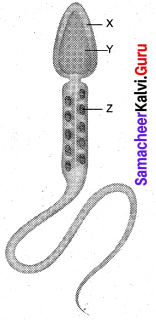

Answer:
(b) Acrosome, Nucleus and Mitochondria
Question 26.
The entire process of spermatogenesis takes about ________ days
(a) 60 days
(b) 44 days
(c) 64 days
(d) 50 days
Answer:
(c) 64 days
Question 27.
Observe the diagram and select the correct option denoting the proper sequence of parts.
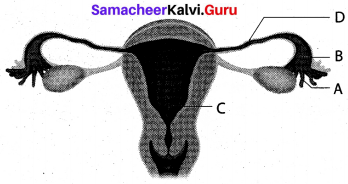

Answer:
(b) Fimbriae, Infundibulum, Uterus and Isthmus
Question 28.
Pick out the incorrect statements.
(a) The upper rounded portion of uterus is fundus.
(b) Uterus open into vagina through narrow cervix.
(c) Cervix is the organ of copulation in female.
(d) Vagina extends from the cervix and opens to exterior.
Answer:
(c) Cervix is the organ of copulation in female.
Question 29.
What is the role of fimbriae?
(a) Secretion of oestrogen and prolactin.
(b) Helps in the collection of the ovum after ovulation.
(c) Attaches the ovary to the abdominal cavity.
(d) Connects oviduct with ovary.
Answer:
(b) Helps in the collection of the ovum after ovulation.
Question 30.
Name the enzyme found in the acrosomal tip of sperm cell.
Answer:
Hyaluronidase
Question 31.
Which is not a correct statement regarding Oogenesis?
Answer:
(i) During foetal development, cells in germinal epithelium of foetal ovary undergo , mitosis and produce oogonia.
(ii) Oogonial cell divide and enter into prophase I of meiosis I and from primary oocytes.
(iii)Primary oocytes later develop into primary follicles.
(iv) No oogonia is formed or added after the foetal birth.
(a) Only i
(b) ii and iii
(c) iv only
(d) None of the above
Answer:
(d) None of the above
Question 32.
In embryo development of human beings, how long does it takes for a zygote to convert into morula?
(a) 24hrs
(b) 36hrs
(c)48hrs
(d) 72hrs
Answer:
(d) 72 hrs
Question 33.
Identify the hormone which is produced only during the time of pregnancy
(a) Relaxin
(b) Oxytocin
(c) Progesterone
(d) Cortisol
Answer:
(a) Relaxin
Question 34.
The type of antibodies present in colostrum.
(a) IgE
(b) IgM
(c) IgA
(d) IgB
Answer:
(c) IgA
2 – Mark Questions
Question 1.
Enumerate the functions of reproductive system.
Answer:
The reproductive system has four main functions namely,
- to produce the gametes namely sperms and ova
- to transport and sustain these gametes
- to nurture the developing offspring
- to produce hormones
Question 2.
Define the terms
- Insemination
- Fertilization.
Answer:
- Insemination: Transfer of sperms by the male into the female genital tract.
- Fertilization: Fusion of male and female gametes to form zygote, called fertilization.
Question 3.
What are seminiferous tubules? Mention its role.
Answer:
Seminiferous tubules are highly coiled tubules seen in the lobules of testis. They occupy 80% – of testicular substance. They are the site for sperm production.
Question 4.
Name the cells noticed in the epithelial layer of seminiferous tubule.
Answer:
- Sertoli cells or Nurse cells
- Spermatogonic cells or male germ cells.
Question 5.
Mention the role epididymis.
Answer:
- Epididymis is a temporary store house for sperms.
- Sperms undergo physiological maturation, increased motility and fertilizing capacity inside epididymis.
Question 6.
Seminal plasma is acidic or alkaline. Write its composition.
Answer:
- Seminal plasma is alkaline in nature.
- It contains fructose, ascorbic acid, prostaglandins and a coagulating enzyme called „ vesiculase.
Question 7.
Define Semen.
Answer:
Semen or seminal fluid is a milky white fluid which contains sperms and the seminal plasma, which is secreted from the seminal vesicles, prostate gland and the bulbourethral glands.
Question 8.
Why do males have Penis?
Answer:
- Penis is the male external genitalia.
- It functions as both excretory and copulatory organ.
- It is made of special tissue that erects the penis to facilitate insemination.
Question 9.
Point out the female accessory organs.
Answer:
Fallopian tubes, Uterus and Vagina.
Question 10.
Define the nature of uterus.
Answer:
The uterus or womb is a hollow, thick-walled, muscular, highly vascular and inverted pear shaped structure lying in the pelvic cavity between the urinary bladder and rectum.
Question 11.
What are the components that make up external genitalia female?
Answer:
Labia Majora, Labia Minora, Hymen and Clitoris.
Question 12.
Name the accessory reproductive glands in female which are homologous to (a) Cowper’s gland and (b) Prostate gland.
Answer:
In female, Bartholin’s gland is homologous to Cowper’s gland and Skene’s gland is homologous to prostate gland.
Question 13.
Define Gametogenesis.
Answer:
Gametogenesis is the process of formation of gametes i.e., sperms and ovary from the primary ,sex organs in all sexually reproducing organisms. Meiosis plays the most significant role in the process of gametogenesis.
Question 14.
Define the terms
- Spermiogenesis
- Spermiation
Answer:
- Spermiogenesis : Transformation of spermatids into mature sperm.
- Spermiation : Release of mature sperm into the lumen of seminiferous tubule.
Question 15.
What do you mean by ‘Sperm lysin’? Mention its function.
Answer:
- Sperm lysin is a proteolytic enzyme secreted in the acrosome of sperm.
- It helps to penetrate the ovum during fertilization.
- It is also called as hyaluronidase.
Question 16.
Name the four phases of menstrual cycle.
Answer:
- Menstrual phase
- Follicular or proliferative phase
- Ovulatory phase
- Luteal or secretory phase
Question 17.
What is corpus albicans?
Answer:
In the absence of fertilization, the corpus luteum degenerates completely and leaves a scar tissue called corpus albicans. It also initiates the disintegration of the endometrium leading to menstruation, marking the next cycle.
Question 18.
Define menopause.
Answer:
Menopause is the phase in a women’s life when ovulation and menstruation stops. The average age of menopause is 45-50 years. It indicates the permanent cessation of the primary functions of the ovaries.
Question 19.
When does capacitation occurs? Define it.
Answer:
The sperms deposited in the female reproductive tract undergo capacitation. It is a bio chemical event that makes the sperm to penetrate and fertilize the egg.
Question 20.
Write a brief note on ectopic pregnancy?
Answer:
If the fertilized ovum is implanted outside the uterus it results in ectopic pregnancy. About 95 percent of ectopic pregnancies occur in the fallopian tube. The growth of the embryo may cause internal bleeding, infection and in some cases even death due to rupture of the fallopian tube.
Question 21.
Point out the extra embryonic membranes of human embryo.
Answer:
- amnion
- Chorion
- allantois
- Yolk nac
Question 22.
What is placenta?
Answer:
Placenta is a temporary endocrine organ formed during pregnancy and it connects the foetus to the uterine wall through the umbilical cord. It is the organ by which the nutritive, respiratory and excretory functions are fulfilled.
Question 23.
Name the organs developed from embryonic ectoderm.
Answer:
Brain and spinal cord (CNS), peripheral nervous system (PNS), epidermis and its derivatives and mammary glands.
Question 24.
Mention the hormones secreted by the placenta during pregnancy.
Answer:
- human Chorionic Gonadotropin (hCG)
- human Chorionic Somatomammotropin (hCS)
- human Placental Lactogen (hPL)
- Oestrogen and progesterone and relaxin.
Question 25.
Name the hormones that are secreted in human only during pregnancy.
Answer:
- human Chorionic Gonadotropin (hCG)
- human Chorionic Somatomammotropin (hCS)
- relaxin
Question 26.
State the role of relaxin.
Answer:
Relaxin is an hormone secreted by the placenta during the later phase of pregnancy. It helps in relaxation of pelvis during child birth.
Question 27.
Define parturition and labour.
Answer:
Parturition is the completion of pregnancy and giving birth to the baby. The series of events that expels the infant from the uterus is collectively called “labour”.
Question 28.
What do you mean by ‘false labour’?
Answer:
Throughout pregnancy the uterus undergoes periodic episodes of weak and strong contractions, fhese contractions called Braxter-Hick’s contractions lead to false labour.
Question 29.
Explain the term C-section.
Answer:
When normal vaginal delivery is not possible due to factors like position of the baby and nature of the placenta, the baby is delivered through a surgical incision in the woman’s abdomen and uterus. It is also termed as abdominal delivery or Caesarean Section or ‘C’ Section.
3 – Mark Questions
Question 1.
Compare gametogenesis with organogenesis.
Answer:
Gametogenesis:
- Formation of gametes i.e., Sperm and Ova.
- It takes place in gonads.
Organogenesis:
- Formation of tissues, organs and organ system.
- It takes place in the embryonic germ layers.
Question 2.
What are primary reproductive organs? What role does they play in organisms?
Answer:
The primary reproductive organs namely the ovary and testis are responsible for producing the ova and sperms respectively. Hormones secreted by the pituitary gland and the gonads help in the development of the secondary sexual characteristics, maturation of the reproductive system and regulation of normal functioning of the reproductive system.
Question 3.
Scrotum acts as a thermoregulator – Justify.
Answer:
The scrotum is a sac of skin that hangs outside the abdominal cavity. Since viable sperms cannot be produced at normal body temperature, the scrotum is placed outside the abdominal cavity to provide a temperature 2-3°C lower than the normal internal body temperature. Thus, the scrotum acts as a thermoregulator for spermatogenesis.
Question 4.
Write any three statements on Sertoli cells.
Answer:
- Sertoli cells are elongated and pyramidal cells.
- They provide nourishment to sperm till maturation.
- They secrete a hormone called inhibin which is involved in negative feedback control of sperm production.
Question 5.
Give a brief account on leydig cells.
Answer:
- Interstitial cells of Leydig are seen embedded in the soft connective tissue surrounding the seminiferous tubules.
- These cells are endocrine natured and produce testosterone (androgen).
- These cells are characteristic to mammalian testes.
Question 6.
Name the accessory glands of male reproductive system.
Answer:
- A pair of seminal vesicles.
- A pair of bulbourethral gland (Cowper’s gland).
- A single prostate gland.
Question 7.
State the location and secretion of prostate gland.
Answer:
The prostate encircles the urethra and is just below the urinary bladder and secretes a slightly acidic fluid that contains citrate, several enzymes and prostate specific antigens.
Question 8.
Write a note on hymen.
Answer:
The external opening of the vagina is partially closed by a thin ring of tissue called the hymen. The hymen is often tom during the first coitus (physical union). However in some women it remains intact. It can be stretched or tom due to a sudden fall or jolt and also during strenuous physical activities such as cycling and horseback riding, etc., and therefore cannot be considered as an indicator of a woman’s virginity.
Question 9.
“Role of hormones in spermatogenesis” – comment on the statement.
Answer:
Spermatogenesis starts at the age of puberty and is initiated due to the increase in the release of Gonadotropin Releasing Hormone (GnRH) by the hypothalamus. GnRH acts on the anterior pituitary gland and stimulates the secretion of two gonadotropins namely Follicle Stimulating Hormone (FSH) and Lutenizing Hormone (LH). FSH stimulates testicular growth and enhances the production of Androgen Binding Protein (ABP) by the Sertoli cells and helps in the process of spermiogenesis. LH acts on the Leydig cells and stimulates the synthesis of testosterone which in turn stimulates the process of spermatogenesis.
Question 10.
Define menstrual cycle.
Answer:
The menstrual or ovarian cycle occurs approximately once in every 28/29 days during the reproductive life of the female from menarche (puberty) to menopause except during pregnancy. The cycle of events starting from one menstrual period till the next one is called the menstrual cycle during which cyclic changes occurs in the endometrium every month. Cyclic menstruation is an indicator of normal reproductive phase.
Question 11.
Luteal phase of menstrual cycle is also called as secretory phase. Why?
Answer:
After ovulation, the graafian follicle turns into corpus luteum (a transistory endocrine gland) which secrets progesterone. Progesterone maintain endometrium for implantation of fertilized ovum, the endometrium of uterus also secretes nutritious fluid for the foetus. Hence this phase is also referred as secretory phase.
Question 12.
Menstrual hygiene is essential for women. Why?
Answer:
Menstrual hygiene is vital for good health, well-being, dignity, empowerment and productivity of women. The impact of poor menstrual hygiene on girls is increased stress levels, fear and embarrassment during menstruation. This can keep girls inactive during such periods leading to absenteeism from school.
Question 13.
Name the absorbents or materials used to manage menstruation.
Answer:
Clean and safe absorbable clothing materials, sanitary napkins, pads, tampons and menstrual cups have been identified as materials used to manage menstruation.
Question 14.
Explain acrosomal reaction.
Answer:
The follicular cells of egg are held together by an adhesive cementing substance called hyaluronic acid. The acrosomal membrane disintegrates releasing the proteolytic enzyme, hyaluronidase during sperm entry through the corona radiata and zona pellucida. This is called
acrosomal reaction.
Question 15.
Differentiate between monozygotic and Dizygotic twins.
Answer:
Monozygotic twins:
- Monozygotic (Identical) twins are produced when a single fertilized egg splits into two during the first cleavage.
- They are of the same sex, look alike and share the same genes.
Dizygotic twins:
- Dizygotic (Fraternal) twins are produced when two separate eggs are fertilized by two separate sperms.
- The twins may be of the same sex or different sex and are non-identical.
Question 16.
What is morula?
Answer:
The first cleavage in zygote produces two identical cells called blastomeres. These produce 4 cells, then 8 and so on. After 72 hours of fertilization, a loose collection of cells forms a berry shaped cluster of 16 or more cells called the morula.
Question 17.
Explain gastrulation.
Answer:
The inner cell mass in the blastula is differentiated into epiblast and hypoblast immediately after implantation. The hypoblast is the embryonic endoderm and the epiblast is the ectoderm. The cells remaining in between the epiblast and the endoderm form the mesoderm. Thus the transformation of the blastocyst into a gastrula with the primary germ layers by the movement of the blastomeres is called gastrulation.
Question 18.
Name the three primary germ layers of embryo. Also mention any three organs or ortgan systems developing from each layer.
Answer:

Question 19.
Define lactation and explain its hormonal background.
Answer:
Lactation is the production of milk by mammary glands. The mammary glands show changes during every menstrual cycle, during pregnancy and lactation. Increased level of oestrogens, progesterone and human Placental Lactogen (hPL) towards the end of pregnancy stimulate the hypothalamus towards prolactin – releasing factors. The anterior pituitary responds by secreting prolactin which plays a major role in lactogenesis.
Question 20.
What is “let-down reflex”?
Answer:
Oxytocin causes the “Let-Down” reflex the actual ejection of milk from the alveoli of the mammary glands. During lactation, oxytocin also stimulates the recently emptied uterus to contract, helping it to return to pre – pregnancy size.
Question 21.
Explain Foetal-ejection reflex.
Answer:
As the pregnancy progresses, increase in the oestrogen concentration promotes uterine contractions. These uterine contractions facilitate moulding of the foetus and downward movement of the foetus. The descent of the foetus causes dilation of cervix of the uterus and vaginal canal resulting in a neurohumoral reflex called Foetal ejection reflex or Ferguson reflex. This initiates the secretion of oxytocin from the neurohypophysis which in turn brings about the powerful contraction of the uterine muscles and leads to the expulsion of the baby through the birth canal.
Question 22.
Give an account on uterine wall layers.
Answer:
The wall of the uterus has three layers of tissues. The outermost thin membranous serous layer called the perimetrium, the middle thick muscular layer called myometrium and the inner glandular layer called endometrium. The endometrium undergoes cyclic changes during the menstrual cycle while myometrium exhibits strong contractions during parturition
5 – Mark Questions
Question 1.
Describe the structure of human ovary.
Answer:
- Ovaries are the primary female sex organ producing eggs (ovum).
- They are located one on each side of lower abdomen (pelvis).
- The ovary is attached in pelvic wall uterus by an ovarian ligament called mesovarium.
- It is an elliptical structure of 2-4 cm long
- Each ovary is covered by thin cuboidal germinal epithelium encloses ovarian stroma.
- Below germinal epithelium is a dense connective tissue called tunica albuginea.
- The stroma is differentiated into outer cortex and inner medulla.
- The cortex is dense and granular due to follicular cells at varying development stages.
- The medulla is a loose connective tissue with blood vessels, lymph vessels and nerve
Question 2.
Explain the structure and function of mammary glands.
Answer:
The mammary glands are modified sweat glands present in both sexes. It is rudimentary in the males and functional in the females. A pair of mammary glands is located in the thoracic region. It contains glandular tissue and variable quantities of fat with a median nipple surrounded by a pigmented area called the areola. Several sebaceous glands called the areolar glands are found on the surface and they reduce cracking of the skin of the nipple. Internally each mammary gland consists of 2-25 lobes, separated by fat and connective tissues.
Each lobe is made up of lobules which contain acini or alveoli lined by epithelial cells. Cells of the alveoli secrete milk. The alveoli open into mammary tubules. The tubules of each lobe join to form a mammary duct. Several mammary ducts join to form wider mammary ampulla which is connected to the lactiferous duct in the nipple. Under the nipple, each lactiferous duct expands to form the lactiferous sinus which serves as a reservoir of milk. Each lactiferous duct opens separately by a minute pore on the surface of the nipple.
Normal development of the breast begins at puberty and progresses with changes during each menstrual cycle. In non-pregnant women, the glandular structure is largely underdeveloped and the breast size is largely due to amount of fat deposits. The size of the breast does not have an influence on the efficiency of lactation.
Question 3.
Describe the spermatogenesis with diagram.
Answer:
Spermatogenesis is the sequence of events in the seminiferous tubules of the testes that produce the male gametes, the sperms.
During development, the primordial germ cells migrate into the testes and become immature germ cells called sperm mother cells or spermatogonia in the inner surfaces of the seminiferous tubules. The spermatogonia begin to undergo mitotic division at puberty and continue throughout life.
In the first stage of spermatogenesis, the spermatogonia migrate among sertoli cells towards the central lumen of the seminiferous tubule and become modified and enlarged to form primary spermatocytes which are diploid with 23 pairs i.e., 46 chromosomes. Some of the primary spermatocytes undergo first meiotic division to form two secondary spermatocytes which are haploid with 23 chromosomes each.
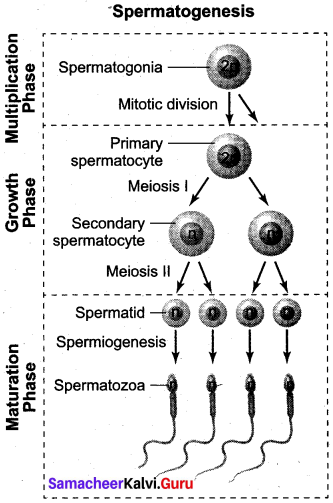
The secondary spermatocytes undergo second meiotic division to produce four haploid spermatids. The spermatids are transformed into mature spermatozoa (sperms) by the process called spermiogenesis. Sperms are finally released into the cavity of seminiferous tubules by a process called spermiation The whole process of spermatogenesis takes about 64 days. At any given time, different regions of the seminiferous tubules contain spermatocytes in different stages of development.
The sperm production remains nearly constant at a rate of about 200 million sperms per day. Spermatogenesis starts at the age of puberty and is initiated due to the increase in the – release of Gonadotropin Releasing Hormone (GnRH) by the hypothalamus. GnRH acts on the anterior pituitary gland and stimulates the secretion of two gonadotropins namely Follicle Stimulating Hormone (FSH) and Lutenizing Hormone (LH). FSH stimulates testicular growth and enhances the production of Androgen Binding Protein (ABP) by the sertoli cells and helps in the process of spermiogenesis. LH acts on the Leydig cells and stimulates the synthesis of testosterone which in turn stimulates the process of spermatogenesis.
Question 4.
Describe the structure of human spermatozoan.
Answer:
The human sperm is a microscopic, flagellated and motile gamete. The whole body of the sperm is enveloped by P plasma membrane and is composed of a head, neck and a tail. The head comprises of two parts namely acrosome and nucleus. Acrosome is a small cap like pointed structure present at the tip of the nucleus and is formed mainly from the Golgi body of the spermatid. It contains hyaluronidase, a proteolytic enzyme, popularly known as sperm lysin which I helps to penetrate the ovum during fertilization. The nucleus is flat and oval. The neck is very short and is present between the head and the middle piece. It contains the proximal centriole towards the nucleus which plays a role in the first
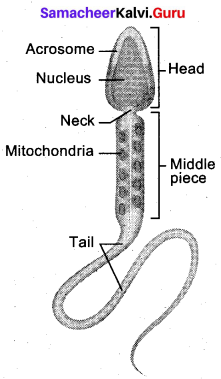
division of the zygote and the distal centriole gives rise to I the axial filament of the sperm. The middle piece possesses mitochondria spirally twisted around the axial filament called mitochondrial spiral or nebenkem. It produces energy in the form of ATP molecules for the movement of sperms.The tail is the longest part of the sperm and is slender and tapering. It is formed of a central ! axial filament or axoneme and an outer protoplasmic sheath. The lashing movements of the tail, push the sperm forward.
Question 5.
Explain the process of oogenesis.
Answer:
Oogenesis is the process of development of the female gamete or ovum or egg in the ovaries. During foetal development, certain cells in the germinal epithelium of the foetal ovary divide by mitosis and produce millions of egg mother cells or oogonia. No more oogonia are formed or added after birth.
The oogonial cells start dividing and enter into Prophase-I of meiotic division-I to form the primary oocytes which are temporarily arrested at this stage. The primary oocytes then get surrounded by a single layer of granulosa cells to form the primordial or primary follicles. A large number of follicles degenerate during the period from birth to puberty, so at puberty only 60,000 to 80,000 follicles are left in each ovary.
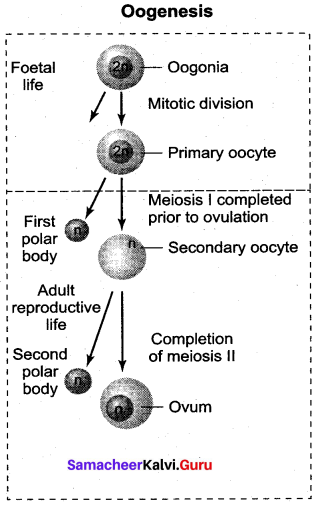
The primary follicle gets surrounded by many layers of granulosa cells and a new theca layer to form the secondary follicle. A fluid filled Oogenesis space, the antrum develops in the follicle and gets transformed into a tertiary follicle. The theca layer gets organized into an inner theca interna and an outer theca externa. At this time, the primary oocyte within the tertiary follicle grows in size and completes its first meiotic division and forms the secondary oocyte.
It is an unequal division resulting in the formation of a large haploid secondary oocyte and a first polar body. The first polar body disintegrates. During fertilization, the secondary oocyte undergoes second meiotic division and produces a large cell, the ovum and a second polar body. The second polar body also degenerates. The tertiary follicle eventually becomes a mature follicle or Graafian follicle. If fertilisation does not take place, second meiotic division is never completed and the egg disintegrates. At the end of gametogenesis in females, each primary oocyte gives rise to only one haploid ovum.
Question 6.
Write a note on embryonic membranes
Answer:
The extra embryonic membranes include amnion, yolk sac, allantois and chorion. They protect the embryo from dessication, mechanical shock, absorption of nutrients, gaseous exchange and placental formatio
Answer:
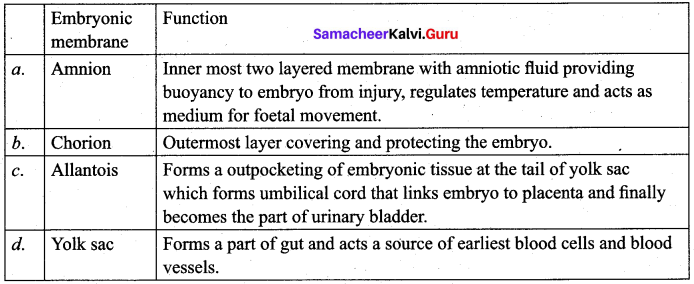
Question 7.
Name the three primary germ layers of embryo. Also mention any three organs or organ systems developing from each layer.
Answer:

Higher Order Thinking Skills (HOTs) Questions
Questio 1.
Give the alternate terminologies for
- Spermatogonia
- Embryonic ectoderm
Answer:
- Spermatogonia = Sperm mother cell
- Embryonic ectoderm = hypoblast
Question 2.
Mention the production site and action site of following hormones.
(a) GnRH
(b) Relaxin
Answer:

Questio 3.
May 28th is celebrated as annual Menstrual Hygiene Day (MHD). State its importance.
Answer:
MHgD aims to create awareness of importance for women and girls to hygienically manage their menstruation. Menstrual hygiene is vital for good health, well-being, dignity, empowerment and productivity of women.
Questio 4.
Suggest few hygiene tips to face healthy and happy menses.
Answer:
- Change the napkins periodically for 4 to 6 hours.
- Wash your genitals properly using clean lukewarm water.
- Avoid using soaps and vaginal hygiene products.
- Discard the sanitary napkins by incinerating.
- Wear clean and comfortable underwear. Avoid tight clothing.
- Have healthy diet rich in Iron content and vitamins.
Samacheer Kalvi 12th Bio Zoology Chapter Wise Solutions PDF will help you to clear all doubts. Learn perfectly by using Samacheer Kalvi 12th Chapter 2 Human Reproduction Questions and Answers Bio Zoology Solutions PDF. Leave us a comment to clear your queries. Get instant updates by bookmarking our site. Get the best learning with the effective and excellent step by step Samacheer Kalvi 12th Bio Zoology Guide.